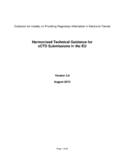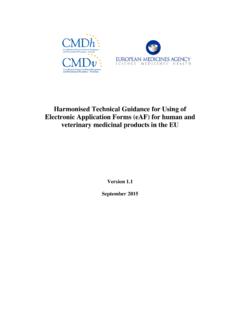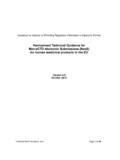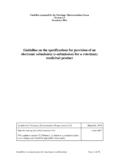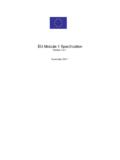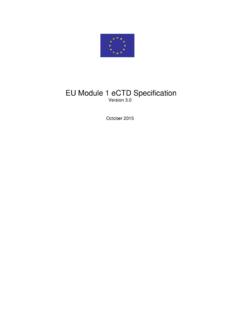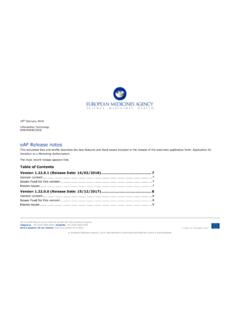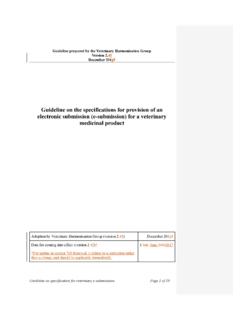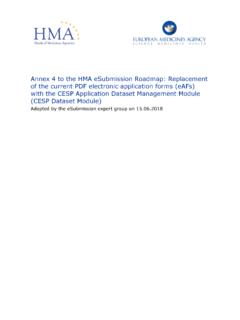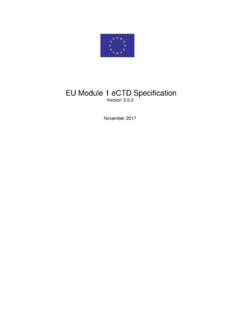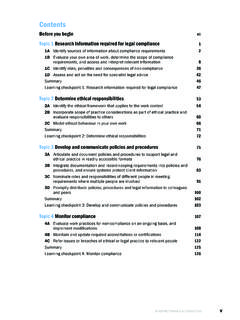Transcription of eCTD Guidance Document - Europa
1 Guidance for Industry on Providing Regulatory Information in Electronic Format: eCTD Version: , August 2011 1 (46) Guidance for Industry on Providing Regulatory Information in Electronic Format TIGes harmonised Guidance for eCTD Submissions in the EU Version August 2011 This Document is published under the auspices of the EU Telematics Implementation Group - electronic submissions (TIGes) Guidance for Industry on Providing Regulatory Information in Electronic Format: eCTD Version: , August 2011 2 (46) Table of Contents 1. INTRODUCTION .. Glossary .. 42. GENERAL CONSIDERATIONS .. Scope .. Structure of Submissions .. Transitional Arrangements .. Moving to eCTD Format from Paper or NeeS Type Applications .. General Submission Considerations .. Correspondence .. Paper Requirements.
2 Hardware .. General Technical eCTD Information .. Other Technical Information .. Number of Media Requested .. Technical Baseline Applications .. 153. MODULE SPECIFIC INFORMATION .. General Information .. Module 1 eCTD Envelope, Administrative Information and Prescribing Information Folder . Module 2 Overviews and Summaries Folder .. Module 3 Quality Folder .. Module 4 Nonclinical Study Reports Folder .. Module 5 Clinical Study Reports Folder .. 224. ADVICE ON SPECIFIC APPLICATION TYPES .. Initial MA Applications .. Variation Applications .. Extension Submissions .. Renewal Submissions .. PSURs .. MRP and DCP Applications .. Referrals .. Active Substance Master Files .. Vaccine Antigen Master Files .. Plasma Master Files .. Applicant Initiated Withdrawals .. Duplicate Applications.
3 29 ANNEX 1: ECTD REFERENCE DOCUMENTS .. 30 ANNEX 2: Guidance ON TEXT SEARCHABLE DOCUMENTS .. 31A2-1 General .. 31A2-2 Documents that Must Always Be Text Searchable .. 31A2-3 Documents that Do Not Need to Be Text Searchable .. 32A2-4. Further Information .. 32 ANNEX 3: Guidance AND BEST PRACTICE ON THE STRUCTURE OF MODULE 3 .. 33A3-1. Introduction .. 33A3-2 General Principles .. 33A3-3 Module 3 XML Attributes in the eCTD .. 36 Guidance for Industry on Providing Regulatory Information in Electronic Format: eCTD Version: , August 2011 3 (46) 1. INTRODUCTION This Guidance Document is intended to assist pharmaceutical companies with the submission of regulatory information in electronic Common Technical Document format (eCTD) to the National Competent Authorities (hereafter referred to as NCAs) and the European Medicines Agency (hereafter referred to as EMA).
4 The eCTD format is regarded as the principal electronic submission format in EU and is the only electronic format that is accepted by the EMA. However, the Non eCTD electronic Submissions (NeeS) format is also accepted by most NCAs and therefore a Guidance Document for NeeS has been published on the EMA eSubmission website as well. The Guidance has been created by the TIGes Harmonisation Group, a sub-group of the Telematics Implementation Group for electronic submissions (TIGes), and has been adopted for publication by the TIGes. It should be stressed that this Guidance reflects the current situation and will be regularly updated in the light of changes in national and/or European legislation together with further experience gained within NCAs of using information submitted in electronic format. This Document consists of four parts: Introduction, General Considerations, Module Specific Information and Advice on Specific Application Types together with associated annexes.
5 Guidance for Industry on Providing Regulatory Information in Electronic Format: eCTD Version: , August 2011 4 (46) Glossary A brief glossary of terms (for the purpose of this Document only) is indicated below: Term Definition Applicant A pharmaceutical company or its agent that is submitting information in support of an application. Applicant s information Regulatory information submitted by an applicant for, or to maintain, a marketing authorisation that falls within the scope of this Guidance Document . eCTD application A collection of electronic documents compiled by a pharmaceutical company or its agent in compliance with European legislation and guidelines in order to seek a marketing authorisation or any amendments thereof. An eCTD application may comprise a number of sequences.
6 In the EU an eCTD application may comprise several dosage forms and strengths, all under one invented product name. Some review tools describe such a collection as a dossier. Procedure A Community registration procedure for the authorisation of medicinal products in the European Community. There are 4 types of procedure that operate within the EC Centralised, Decentralised, Mutual Recognition and National. Submission or Sequence A single set of information and/or electronic documents supplied at one particular time by the applicant as a part of, or the complete, eCTD Application. In the context of eCTD, this is equivalent to a sequence. Regulatory activity A collection of sequences covering the start to the end of a specific business process, an initial MA application or Type II variation.
7 It is a concept used in some review tools to group together several business related sequences. Guidance for Industry on Providing Regulatory Information in Electronic Format: eCTD Version: , August 2011 5 (46) 2. GENERAL CONSIDERATIONS Scope Types of Product This Guidance covers the submission of electronic regulatory information for all human medicinal products falling within the competence of NCAs in the EEA as well as the EMA. This includes prescription, over the counter medicines, innovative and generic product submissions. The product types include small molecules, biotech products, herbals, vaccines, homeopathics and blood products. Types of Submission This Guidance applies to all submissions related to the authorisation and maintenance of medicinal products, including new marketing authorisations, variations, renewals, PSURs, active substance master files (ASMF) and Plasma Master Files (PMF).
8 For variations, ASMF and PMF there are also specific Guidance documents (see references in Part 4). Types of Procedures This Guidance covers applications made in any of the applicable Community procedures (National, Mutual Recognition, Decentralised and Centralised). Exceptions This Guidance does not apply to the electronic submission of pre-MA information such as scientific advice, clinical trial applications, Orphan drug designations, PIP submissions and related submission correspondence. Structure of Submissions This Document provides Guidance on how to organise application information for electronic submission using the eCTD specifications. Guidance on the detailed information to be included is described in the Common Technical Document (CTD), and relevant ICH and EU Q&A documents.
9 The structure and organisation of an eCTD submission is defined by the following standards : ICH M2 eCTD Specification EU Module 1 Specification Relevant ICH and EU Q&A docs Annex 1 contains links to the currently approved version of these documents. Typically, an eCTD application will cover all dosage forms and strengths of a product. In the centralised procedure, this will be equivalent to all dosage forms and strengths covered by an EMA application number ( EMEA/H/C/123). In MRP/DCP, a single eCTD application should preferably be used for the procedure. However if an applicant decides not to apply for all strengths and dosage forms in every member state in the procedure, the possibility of having one eCTD application per strength/dosage form should be considered.
10 Applicants should carefully consider what an eCTD application should cover before submitting the first sequence, as the choice could have implications for workload for the lifespan of the product. For example, if the applicant decides to have one eCTD per strength or dosage form, it is expected that each of these eCTD applications will be maintained individually, such that submission of a single sequence that covers more than one strength or dosage form will no longer be possible if very good reasons are not presented for a change over. In these rare cases, please contact the NCA/RMS/EMA concerned at an early planning stage. For further details on the pros and cons of the different approaches to dossier structure, see Annex 3, Table 1. Please check for specific NCA Guidance when preparing national eCTDs.
